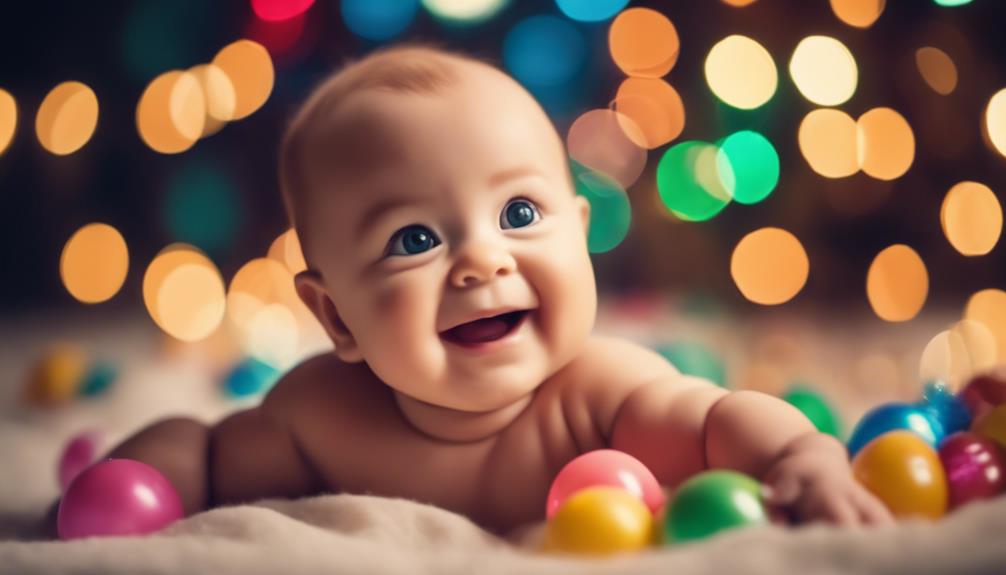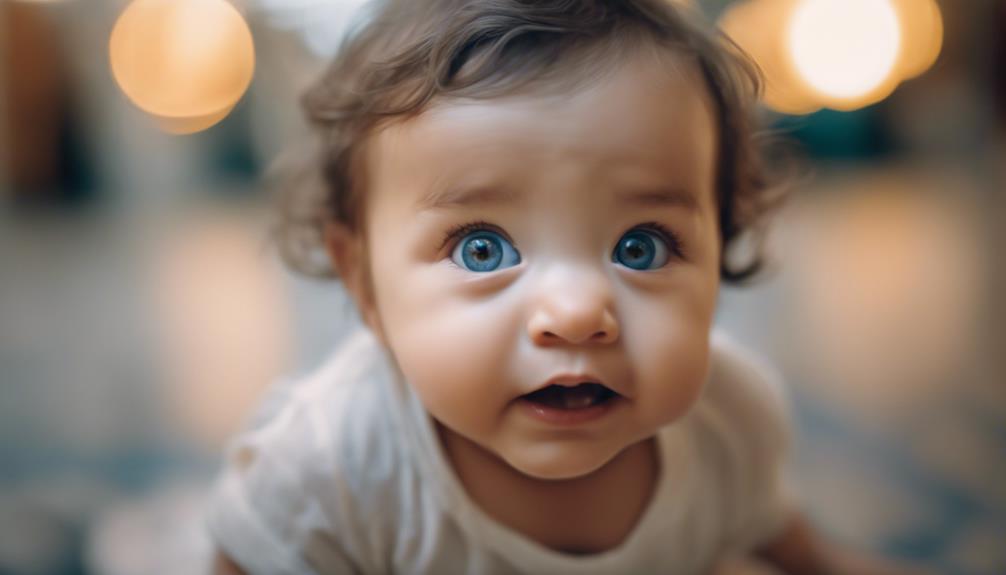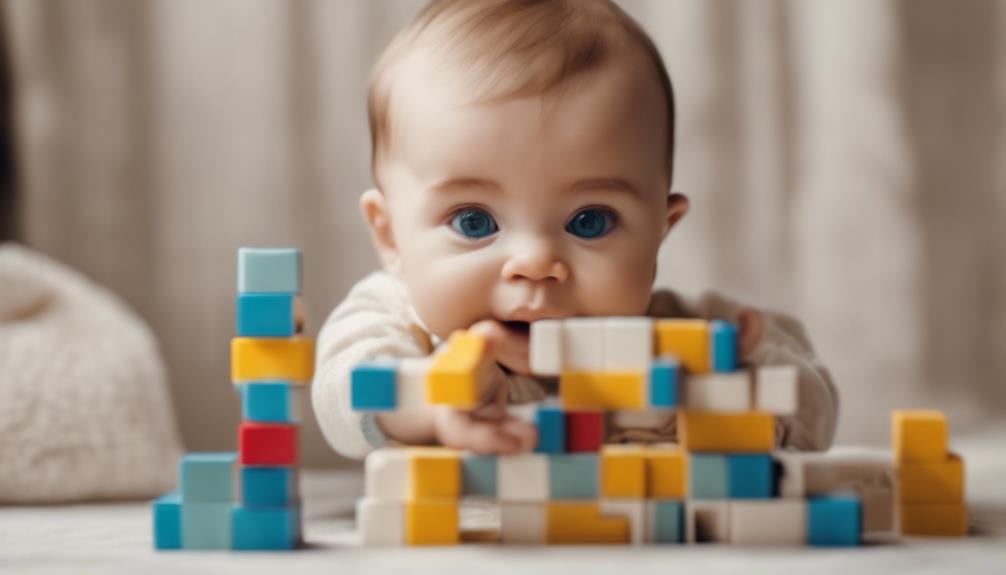To determine if your baby is happy, look for the following signs: smiles that indicate love, eye contact for bonding, cooing and babbling as a form of communication, excited movements such as kicking legs, reaching for cuddles for comfort, observant behavior to show curiosity, playful actions for bonding, contentment indicating satisfaction, and peaceful sleep patterns. Recognizing these cues will enhance your connection and understanding with your baby, creating a loving and secure environment for their growth and development. Your attentive observation will help build a strong emotional bond with your little one, leading to a rewarding and joyful parenting experience.
Key Takeaways
- Smiling: A sign of love and connection, showing emotional well-being and contentment.
- Eye Contact: Seeking faces for recognition, building trust and familiarity.
- Cooing and Babbling: Expressing affection, enhancing communication skills, and bonding.
- Excited Movements: Joyful expressions, kicking legs, and engagement indicate happiness.
- Reaching for Cuddles: Signifying joy, comfort, and emotional connection.
Smiling
Babies express happiness primarily through their smiles, showcasing their contentment and emotional well-being.
When your little one flashes those adorable baby smiles, it's not just a cute expression – it's a sign of love and connection.
Around 2 months of age, you may notice those social smiles starting to bloom, revealing the emotional bond between you and your baby.
Eye Contact

Establishing eye contact with your newborn is essential for building a strong emotional connection and sense of security. When it comes to eye contact, your baby is communicating more than you may realize.
Here are some key points to take into account:
- Newborn Orientation: Notice how your baby naturally turns their gaze towards faces, signaling an early form of recognition and connection.
- Facial Imitation: Watch as your baby mimics your facial expressions, demonstrating engagement and a desire for social interaction.
- Bond Strengthening: Making eye contact with your baby strengthens the bond between you, fostering trust and emotional security.
- Caregiver Recognition: Through eye contact, babies begin to recognize their caregivers, building a foundation of security and familiarity.
Cooing and Babbling

Engaging in verbal interactions with your baby through cooing and babbling is an essential way to strengthen your bond and promote emotional expression. Babies start expressing themselves early through these adorable sounds, showing their affection and connection with you. Encouraging these verbal interactions creates a unique opportunity for you to engage in 'conversations' with your little one, fostering communication and deepening your bond.
Here's a quick overview of the significance of babies starting cooing and babbling:
| Benefits of Cooing and Babbling | Description | Impact |
|---|---|---|
| Emotional Expression | Shows affection and connection | Strengthens bond |
| Communication Development | Fosters early communication skills | Enhances bonding |
| Attachment Building | Promotes emotional connection | Strengthens caregiver-baby relationship |
Excited Movements
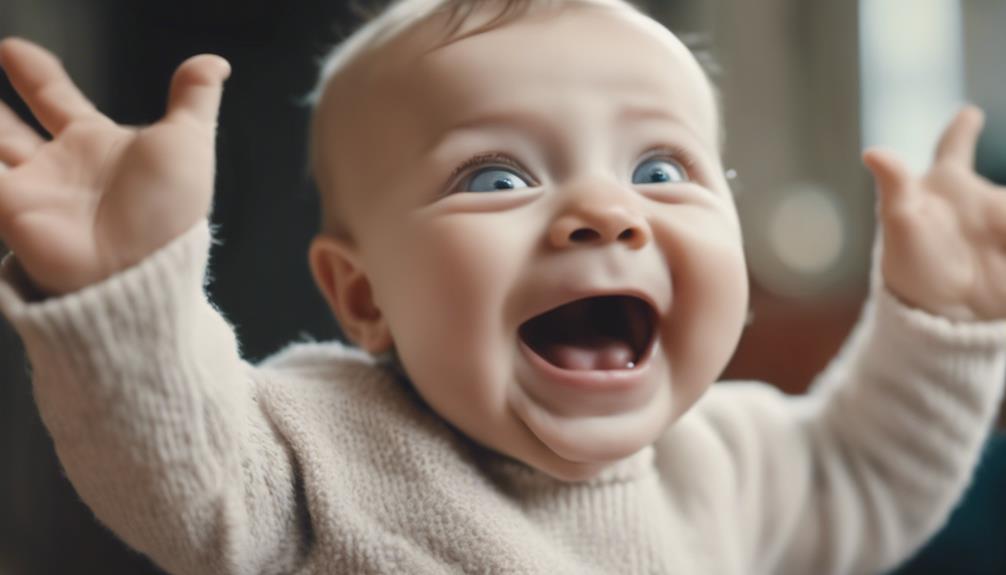
During moments of happiness, observe your baby exhibiting excited movements like kicking their legs and waving their arms. These movements are clear indicators that your little one is feeling joyful and content. Here are some key things to look out for:
- Watch for joyful expressions like big smiles and giggles during playtime. These outward signs of happiness show that your baby is enthusiastic and engaged in their surroundings.
- Excited movements may include bouncing up and down or reaching out eagerly. Your baby's eagerness can be seen through their energetic actions.
- Pay attention to your baby's body language for signs of happiness, like clapping hands or squealing with delight. These gestures show how your baby expresses their joy physically.
- Happy babies may show enthusiasm by babbling or cooing with excitement. Their vocalizations can also be a sign of their happiness and contentment.
Reaching for Cuddles
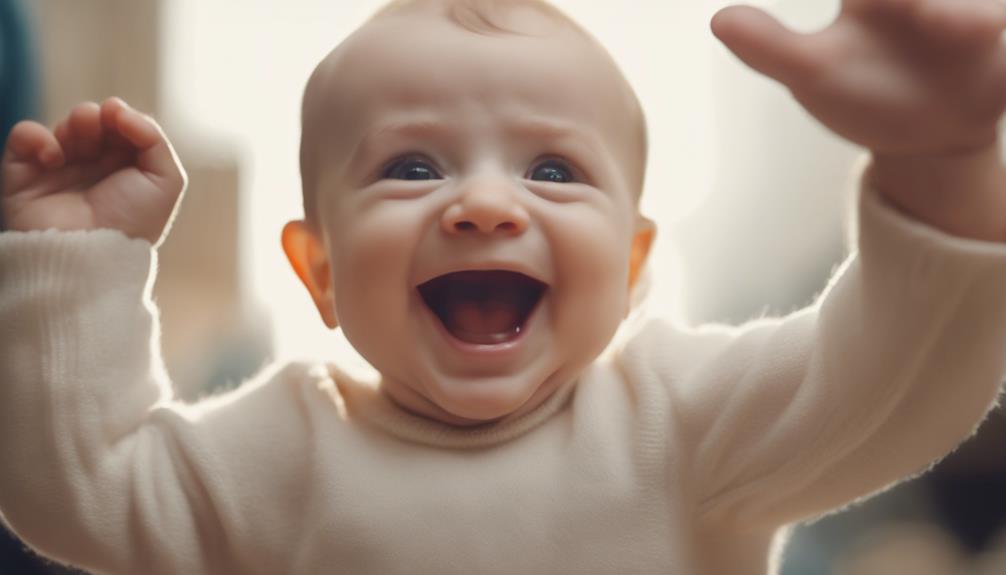
When your baby reaches out for cuddles, it's a heartwarming sign of joy.
This gesture shows that they seek physical closeness and comfort in your arms.
Embrace these moments to strengthen your bond and create a sense of security and love.
Joy in Reaching Out
Reaching out for cuddles is a clear indicator that your baby is experiencing joy and comfort in their interactions with you. It's a beautiful sign of their happiness and emotional connection with you.
Here are some key points to help you understand the joy your baby feels when reaching out for cuddles:
- Emotional Bond: Your baby seeking physical contact through reaching out signifies a strong emotional bond between you both.
- Comfort and Happiness: By initiating physical contact, your baby is expressing their happiness and contentment in your presence.
- Positive Indicator: Reaching for cuddles is a positive sign of your baby's emotional well-being, showing that they feel safe and loved.
- Mutual Affection: Your baby's desire to cuddle reflects the mutual affection and trust that exists in your relationship.
Next, we'll delve into how your baby seeks physical closeness, further deepening the bond between you both.
Seeking Physical Closeness
Seeking physical closeness through cuddles is a heartwarming way for your baby to express their need for comfort and connection with you. When babies reach for cuddles, they're showing their affection and attachment to you, their caregiver. This act not only communicates a desire for physical reassurance but also fosters a sense of security and emotional bonding.
Responding to your baby's cues for cuddles can strengthen the special bond you share.
Babies seeking physical closeness through cuddles demonstrate their need for affection and closeness. By embracing these moments of connection, you're helping your baby feel loved and cared for. Offering cuddles when your baby reaches out can provide them with the comfort and reassurance they seek, promoting a deeper sense of attachment between you both.
Expressing Comfort Through Touch
Babies express their comfort and happiness by naturally reaching out for cuddles and seeking physical closeness. Even very young babies show their contentment by reaching for cuddles in a heartwarming display of affection.
When your baby loves being held and comforted, it's a clear sign that they feel secure and content in your arms. Here are some key points to take into account when your little one reaches out for cuddles:
- Sign of Connection: Reaching for cuddles demonstrates your baby's desire for connection and reassurance from you.
- Feeling Safe and Loved: Physical touch and closeness help your baby feel safe, loved, and emotionally secure.
- Trust and Attachment: Babies who reach out for cuddles exhibit trust and attachment to their caregivers, showing a strong bond.
- Emotional Security: Seeking to be held and comforted is a beautiful way for your baby to express their emotional security and happiness in your presence.
Sense of Calmness
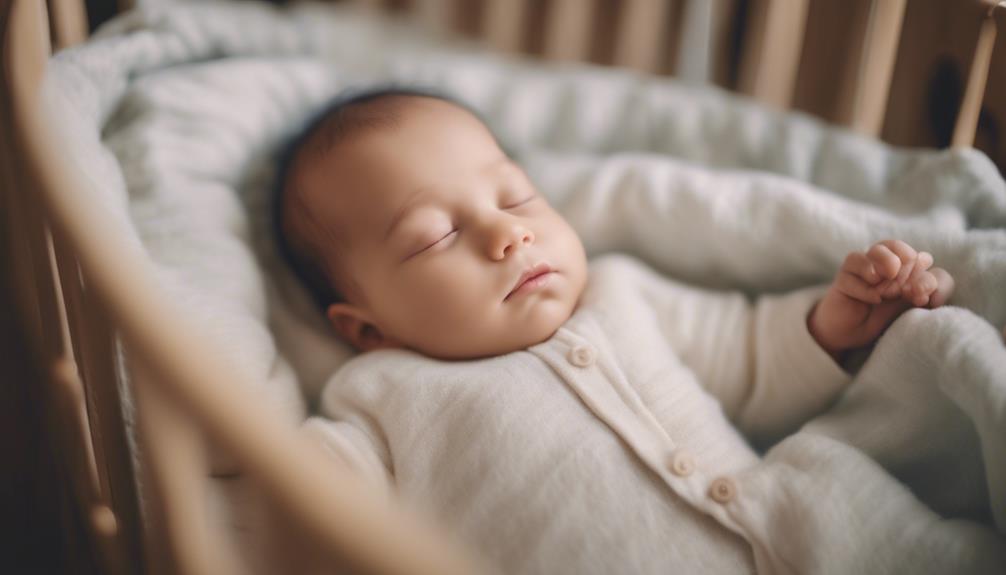
Noticing a sense of calmness in your baby's demeanor can be a clear indicator of their happiness. A happy baby often exudes tranquility, showing a peaceful state of mind and a lack of fussiness.
When your little one relaxes in your arms with gentle movements and a serene expression, it's a beautiful sign of contentment. Watch for subtle cues like steady breathing, a relaxed body posture, and an absence of crying or restlessness. These are all indications that your baby is feeling secure and joyful in their environment.
By paying attention to these signs of calmness, you can understand your baby's emotional state better and foster a nurturing atmosphere for them to thrive in. Remember, a happy and content baby will often radiate a sense of peace, appreciating the care and love they receive from you.
Keep observing their behavior, and cherish these moments of tranquility that reflect your baby's inner happiness.
Interest in Environment
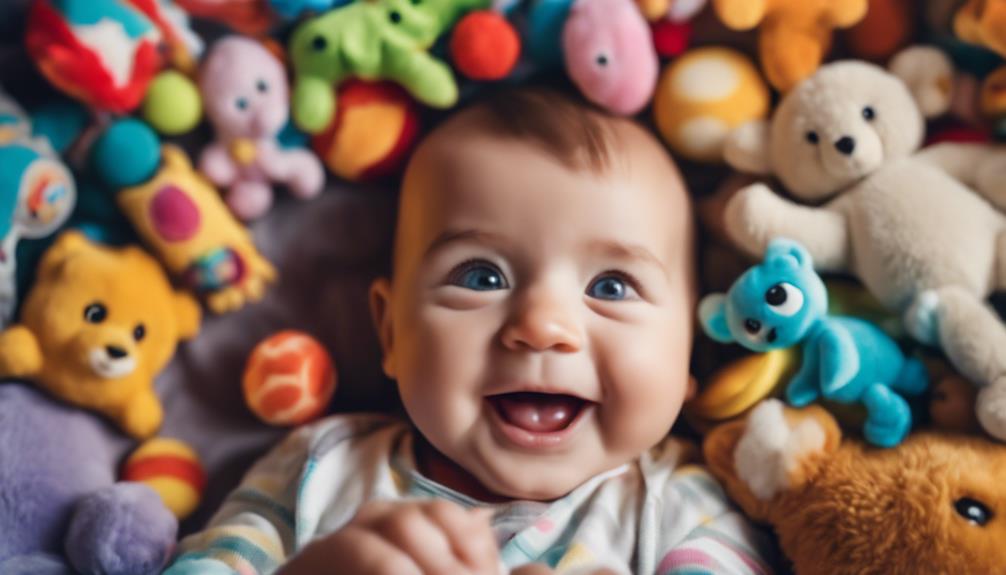
Engaging with the surroundings, your happy baby will show curiosity and attentiveness towards their environment. This interest in the world around them is an important indication of their well-being and contentment.
Here are some signs to watch for:
- Baby Gazes: A happy baby will gaze around, taking in their surroundings with wide-eyed wonder, showing a keen interest in everything they see.
- Exploration: They may reach out to touch objects, explore toys with enthusiasm, and try to grab items within their reach, displaying a desire to interact with their environment.
- Attentive Eyes: Happy babies often have attentive and interested eyes, showing engagement and stimulation in their surroundings, indicating their curiosity and alertness.
- Observant Behavior: Content and happy babies are observant little ones, always keen to interact with the world around them, displaying a sense of wonder and interest in their surroundings.
Encourage and nurture this curiosity as it plays an important role in your baby's development and happiness.
Playful Behavior
To recognize a happy baby's well-being through their playful behavior, observe their interactions, expressions, and sounds during joyful activities. Happy babies often engage in playful behavior by smiling, giggling, and playing with toys. When your little one shows interest and enthusiasm in activities, it's a clear sign of their happiness.
Watch for playful interactions with caregivers, like peek-a-boo or tickling, which indicate a strong sense of joy. During playtime, babies may babble, coo, or make happy sounds, expressing their delight in the moment.
Remember, playful behavior not only signifies happiness but also fosters bonding, communication, and emotional development in your baby. So, encourage these playful moments, cherish the smiles and giggles, and engage in activities that bring out the joy in your little one.
Enjoy these moments of playfulness as they not only indicate happiness but also strengthen the bond between you and your baby.
Contentment

When your baby is content, you'll notice them smiling and cooing, showing their happiness and satisfaction.
A baby with peaceful sleep patterns is likely feeling secure and content in their environment, which is essential for their overall well-being.
Recognizing these signs of contentment can help you nurture a happy and healthy bond with your little one.
Smiling and Cooing
Smiling and cooing are key indicators of contentment and happiness in your baby. When your little one flashes a smile or lets out those adorable coos, it's a clear sign that they're feeling joyful and secure. Here are some important points to take into account:
- Mutual Smiles: Your baby's smile is a precious form of communication. When you smile back, you reinforce the emotional connection between you both, strengthening the bond and promoting feelings of security.
- Verbal Affection: Cooing is more than just cute baby sounds; it's a way for your baby to express affection and happiness. Responding to these coos with your own words and sounds can deepen your connection.
- Emotional Well-Being: Babies often use smiles and vocalizations to convey their emotional state. By paying attention to these cues, you can better understand your baby's level of happiness and satisfaction.
- Communication is Key: Engaging with your baby through smiles and coos creates a positive feedback loop, fostering a supportive environment for emotional development.
Peaceful Sleep Patterns
Peaceful sleep patterns in babies often serve as a clear indicator of contentment and relaxation. When your baby gives you those restful nights of undisturbed sleep, it's a good sign that they're happy and feeling secure.
At around three months of age, you may start noticing more consistent and deep sleep cycles, which reflect your baby's overall well-being. A happy baby typically sleeps soundly, without frequent awakenings or disturbances.
If your little one is able to drift off easily and wake up refreshed, it's a positive sign that they're comfortable and content. By monitoring the quality and duration of your baby's sleep, you can gain valuable insights into their happiness and emotional state.
Well-Being
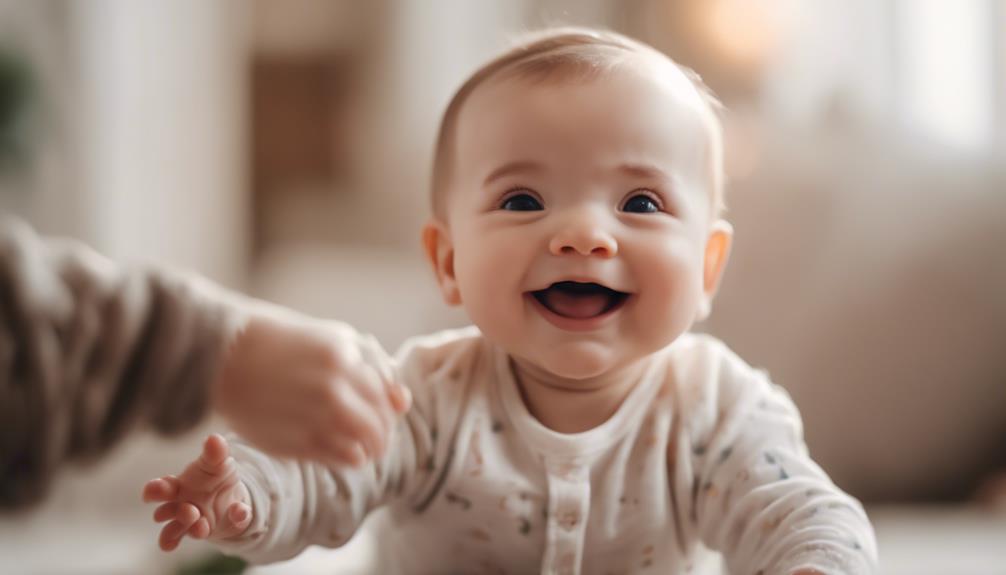
Demonstrating healthy muscle growth and growing independence, your baby's ability to hold their neck properly by 3 months and roll on their tummy with control indicates their well-being.
To guarantee your baby's overall well-being, it's vital to pay attention to various signs that show they're thriving and happy. Here are some key indicators to watch for:
- Regular bowel movements and wet diapers (8-10 times a day) indicate a healthy digestive system and nutrient intake, showing your baby's well-being.
- Baby's contentment in your arms, soothing down, and feeling secure reflect their comfort level and emotional well-being.
- Responding to various sounds, fixing gaze on sources of sound, and developing auditory senses show your baby's sensory awareness and cognitive growth.
- Observing your baby's distress levels, reactions to surroundings, and ability to communicate basic needs through crying help gauge their mood and overall happiness.
Frequently Asked Questions
How to Know if an Infant Is Happy?
To know if your infant is happy, observe for contentment in your arms and signs of comfort. Look for proper neck support by 3 months, eye contact showing recognition, regular bowel movements, wet diapers, and responses to sounds.
How Do I Know if My Baby Is Satisfied?
Feeling unsure if your baby is satisfied? Watch for cues like contentment in your arms, strong neck control by 3 months, frequent bowel movements, responsiveness to sounds, and engaged eye contact. Trust your instincts!
What Determines a Happy Baby?
You determine a happy baby by observing signs like contentment in your arms, regular bowel movements, responsiveness to sounds, interest in surroundings, smiling, and attachment to caregivers. These cues help you gauge your baby's happiness.
How Do You Know a Baby Feels Secure and Happy?
You know a baby feels secure and happy when they have regular bowel movements, sleep deeply, and show comfort through body language. They play vigorously, eat joyfully, and babble with consonant combinations, indicating their sense of security and happiness.
Conclusion
To sum up, if your baby is displaying these 10 signs of happiness, you can rest assured that you're doing a fantastic job as a parent. Keep up the great work and continue to nurture your little one's joy and well-being.
Remember, a happy baby is a healthy baby, so keep an eye out for these cues and enjoy every moment of your little one's happiness!

